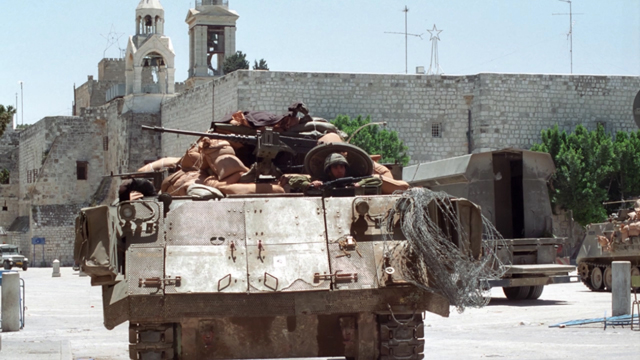Learn about the history of the Palestinian struggle for freedom, equality and justice by exploring major events in the history of their oppression on this day of the year.
10 May
 CHURCH OF THE NATIVITY SIEGE ENDS
CHURCH OF THE NATIVITY SIEGE ENDS
This day in 2002 was the end of the Israeli Army’s 39-day siege of Palestinian fighters in the Church of the Nativity in Bethlehem. During heavy gun battles eight Palestinians were killed. International mediation led to an agreement that 26 fighters would go to Gaza and thirteen would be taken into British Army custody/protection pending their being moved to Italy and Spain. They left the church on May 10th and were greeted by the British Ambassador and 30 British Military Police.
انتهاء حصار كنيسة المهد
10 مايو
كان هذا اليوم من عام 2002 نهاية حصار الجيش الإسرائيلي الذي استمر 39 يومًا للمقاتلين الفلسطينيين في كنيسة المهد في بيت لحم. قُتل ثمانية فلسطينيين خلال معارك عنيفة بالأسلحة النارية.أدت الوساطة الدولية إلى اتفاق على أن 26 مقاتلاً سيذهبون إلى غزة وأن ثلاثة عشر سيؤخذون في حجز / حماية الجيش البريطاني ريثما يتم نقلهم إلى إيطاليا وإسبانيا. غادر المعتصمون الكنيسة يوم 10 مايو وكان في استقبالهم السفير البريطاني و 30 من الشرطة العسكرية البريطانية.
On 29 March 2002, Israel began what it called “Operation Defensive Shield”...At approximately 2am. on 2 April 2002, Israeli occupation forces invaded the neighbouring towns of Bethlehem, Beit Jala, and Beit Sahour, according to the Palestinian Center for Human Rights:
“using approximately 250 tanks and armored personnel carriers, F-16 fighter jets, and Apache gunships. At approximately 04:30, they seized full control over the three cities, except the Old Town.
Trapped between advancing Israeli forces in the center of Bethlehem, approximately 200 Palestinians — mostly civilians and policeman, along with some gunmen from local Fatah militias and Christian clergy — took refuge in the Church of the Nativity, the Christian holy site built over the traditional location where Jesus Christ was born. Palestinians had last sought refuge in the church during Israel’s occupation of the West Bank in 1967.
Read more, including timeline of the siege
Israel commenced a policy of deportation against leaders and activists within the Palestinian political and social communities immediately following the occupation of 1967. This policy, however, didn’t end in the immediate post-war period, but continued due to the lack of international will to prevent such a practice.
by Rasem Obeidat of the AIC (Alternative Infomation Centre) in Jerusalem
Prior to the establishment of the Palestinian Authority, deportations were made to Jordan, Lebanon, Syria and others, but to Jordan and Lebanon in particular. Following the outbreak of the first intifada, Israel stepped up its deportation of activists and leaders, with a peak in December 1992 during which 418 activists from Hamas and the Islamic Jihad were deported to southern Lebanon in response to their military operations. Now, for the first time there was international will to oblige the Israeli government to return the exiles home in the form of UN resolution 799, through which some returned home and others to Israeli prison.
The UN resolution eased Israel’s pace of deportations but following outbreak of the second intifada in September 2000, deportations began in earnest. In May 2002, following Operation Defensive Shield, 39 Palestinian militants barricaded themselves in Bethlehem’s Church of the Nativity. They were exiled to the Gaza Strip and to several European countries, ostensibly for three years, although since that date no one has been allowed to return home. Not even Abdullah Awad, who died in exile; the Israeli government did not allow the return of his body to be buried in his hometown.
Read more
